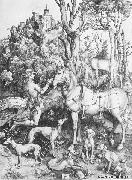Wholesale Oil Painting Reproductions No Minimum and Door to Door! |
|||||||||||
|
|
|||||||||||

|
|||||||||||
|
|
|
||||||||
All Albrecht Durer Oil Paintings |
||||||||
|
|
||||||||
|
|
||||||||
|
Artist Introduction: b.May 21, 1471, Imperial Free City of Nernberg [Germany]
d.April 6, 1528, Nernberg
Albrecht Durer (May 21, 1471 ?C April 6, 1528) was a German painter, printmaker and theorist from Nuremberg. His still-famous works include the Apocalypse woodcuts, Knight, Death, and the Devil (1513), Saint Jerome in his Study (1514) and Melencolia I (1514), which has been the subject of extensive analysis and interpretation. His watercolours mark him as one of the first European landscape artists, while his ambitious woodcuts revolutionized the potential of that medium. D??rer introduction of classical motifs into Northern art, through his knowledge of Italian artists and German humanists, have secured his reputation as one of the most important figures of the Northern Renaissance. This is reinforced by his theoretical treatise which involve principles of mathematics, perspective and ideal proportions.
His prints established his reputation across Europe when he was still in his twenties, and he has been conventionally regarded as the greatest artist of the Renaissance in Northern Europe ever since. |
||||||||
|
|
||||||||
|
St Eustace Painting ID:: 63579 |
1501 Engraving, 355 x 259 mm Fogg Art Museum, Cambridge The print is often erroneously called "St Hubert." This is D?rer's largest single-leaf copper engraving. He frequently sold impressions of it or gave them away as presents during his journey to the Netherlands. The legend of St Eustace is narrated in the Legenda aurea and is freely adapted in D?rer's picture. The Roman officer Placidus was converted to Christianity by a vision of a stag who spoke with the voice of Christ and carried a crucifix in its antlers, and he then took the name of Eustace. Here, the scene is taking place in the middle of a forest landscape, next to a pond. The statue-like depiction of the horse and the greyhounds, which are shown in five different body positions, shows that D?rer was more interested in reproducing proportions than in creating a precisely detailed account of the Christian legend. D?rer carefully avoided any overlapping of the animals. In this end and other details this print is closely related to Pisanello's painting of the same subject (National Gallery, London). The unusually large size of the plate appears to have caused some difficulty in printing. Even some of the best impressions have some squeezed lines near the edges. There are impressions on satin, all posthumous, at Coburg, Boston, Vienna, Gotha and Frankfurt.Artist:D?RER, Albrecht Title: St Eustace Painted in 1501-1550 , German - - graphics : religious |
|||||||
Height Width |
INS/CM Quality |
|||||||
|
CONTACT US |

